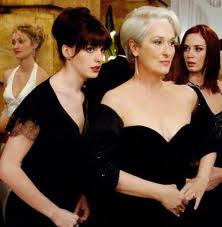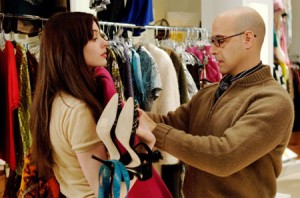Editor’s Note: With the Academy Awards taking place Sunday, TLNT asked some thought leaders to write about their favorite movie with a management or HR theme. We’ll feature these up to the Oscar ceremony on Feb. 27.
By Ron Thomas
“Don’t be ridiculous, everyone wants this,” Editor-in-Chief Miranda coolly stated as she rode through the beautiful streets of Paris in her chauffeur driven S Class Mercedes. The CEO stated in the elevator that “a million girls would kill for that job.”
This was the brand as they saw it in the movie “The Devil Wears Prada.” This was the brand that Andy (played by Anne Hathaway) saw and most definitely the brand that the gatekeepers in HR kept in mind when they decided who could come to interview.
This movie has HR footprints all over it, from branding, recruiting, employee engagement, management dysfunction, succession planning, leadership, mentorship. All the ills of the organization are woven through the narrative of a movie about a young college graduate getting her first job. She’s all wild eyed and eager — until she is thrown into this sink or swim playground.
From a branding prospective, Runway, the magazine at the center of the film, was the fashion bible of the industry. Read and pawned over by the entire industry, it was the voice of the industry. “ You work here and you can work anywhere” was stated throughout the movie. The external brand was burnished into the mindset of the fashion industry.
However, the reality is that this type of company, if run with that same style today, would probably be on its last legs. No company today owns their brand image today. From employees to the consumer, everyone today has a say. The Internet changed all that, and Glassdoor.com and Vault are just a few of the repositories of comments, anecdotes, and insights that you could never have imagined years ago.

The recruiting department at Runway was accused of having a sense of humor for sending Andy in for an interview because she was surely not viewed as cultural fit. However the lesson learned was that when challenged she stepped up to the plate and eventually earned the respect of Miranda more so than some of the other “silly girls” as Miranda reminded her.
How not to interview
Andy showed up clearly not prepared for an interview especially at Runway. To not have heard of Runway and then say you want to be an investigative reporter was beyond puzzling.
There is just no excuse for any job seeker not doing all the research possible before the “audition.” However, she must be given credit for speaking up as a result of the rude interview. The spunk she showed in that scene got her the job.
Onboarding
First day at work and you go straight to your desk and computer. It is important that companies realize that onboarding is the most important phase of the new employee/organization relationship.
If Runway was such an important institution, the historical importance of such a magazine within an industry should be told to every new employee. This narrative, as well as the company values, should have been etched into their mind by end of day. By not connecting on that first day, companies lose a tremendous opportunity to connect. This opportunity will never present itself again.
Leadership
I refer to the style of leadership demonstrated in this movie as trickle down. If your executive team has attitude, it trickles down to the rest of the team (Think how Emily is rude beyond belief and just a high-end administrative assistant). I do not want to even think about what type leader she would become. Nigel, while not as strident as Emily, still demonstrated the touches of arrogance peeking through.
Management by fear was the undercurrent at Runway. The morning scene when Miranda arrives and everyone goes into spasms trying to get into place was sad as well as laughable. The Queen has arrived and everyone must be in their place. This was a toxic environment, where everyone was trying to outdo each other. Forget collaboration and teamwork — just suck up to everyone that is close to Miranda.
The environment was terribly toxic. If someone new and different comes in, they are automatically rejected. This is a direct result of the trickle down effect.

In addition, “command and control” is a dying style of leadership. Successful companies of the future will not allow this style to take root. It is basically obsolete. And the Miranda’s of the executive suite are a dying breed, whether they know it or not.
One redeeming factor is that Emily will never forget the experience that she learned under Miranda’s tutelage. In life you sometimes learn more from a bad boss that you will ever learn from great one. Miranda never acknowledges a job well done whereas she was all over young Emily’s mistakes. If you try the exact opposite, it will definitely work a lot better.
Succession planning
While the CEO was contemplating replacing Miranda, she slyly created her own strategy that would cut him off at the knees. She lay in wait, ready to confront him on her terms. Then, his hand-picked successor was detoured into another position because Miranda was just to cagey for her boss. Even magazine Art Director Nigel (played by Stanley Tucci) who just knew that he was ready for the step up was road kill by the end of the movie.
Managing up
The planning meetings at Runway were an example of team dysfunction. Everyone trying so hard to please was swatted away as if they were an insect. Plus, everyone was afraid to present. Imagine the innovation that comes out of that meeting?
Fast track
It was a warm feeling when Emily crossed the threshold with the Harry Potter book incident. Tried and proven she was now viewed as not only capable, but as Miranda said, “I see a lot of you in me.” The day that she reported to work and the coat was thrown on Andy’s desk was the line of demarcation. She was now the “it” girl.
Mentorship
Nigel, the art director, proved to be a great mentor. Nigel’s sessions with Andy gives us a sense of what the company and industry was all about. He took her under his wing and they developed a strong bond as he walked her through the intricacies of Runway and the fashion industry. He took someone that was accepted at Stanford law school, who wanted so much to be a writer, and coached her into a budding executive in the making. They made such a great team (and they really were an A Team). As Nigel said over a glass of wine, “my work with you is now done.”
This movie was a conglomerate of all aspect of human resources. There were bright spots throughout, but it also wallowed in the depth of a dysfunctional organization.
“The Devil Wears Prada” should be a “must view” for new college graduates stepping into the world of work. Yes, there are a lot of great lessons that a newbie could get from this.
http://www.youtube.com/watch?v=hbthtLM5VS4&feature=related
